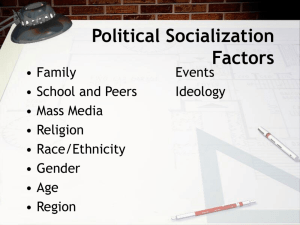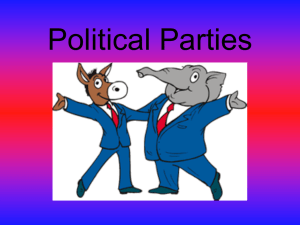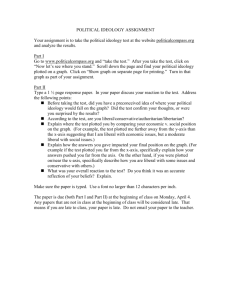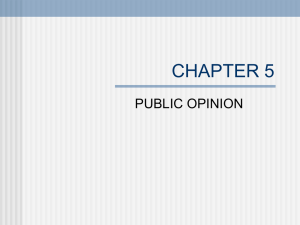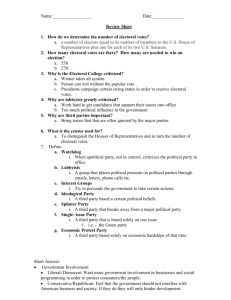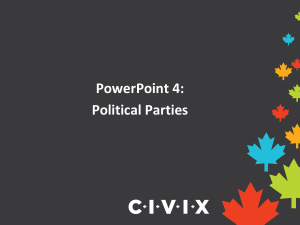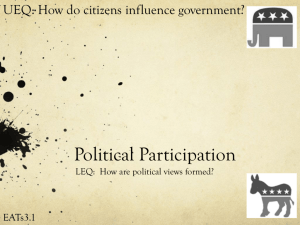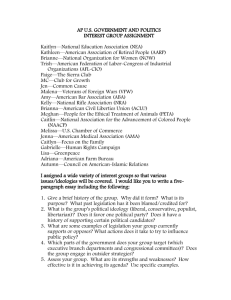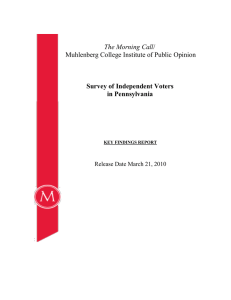Final Lecture - College Home
advertisement
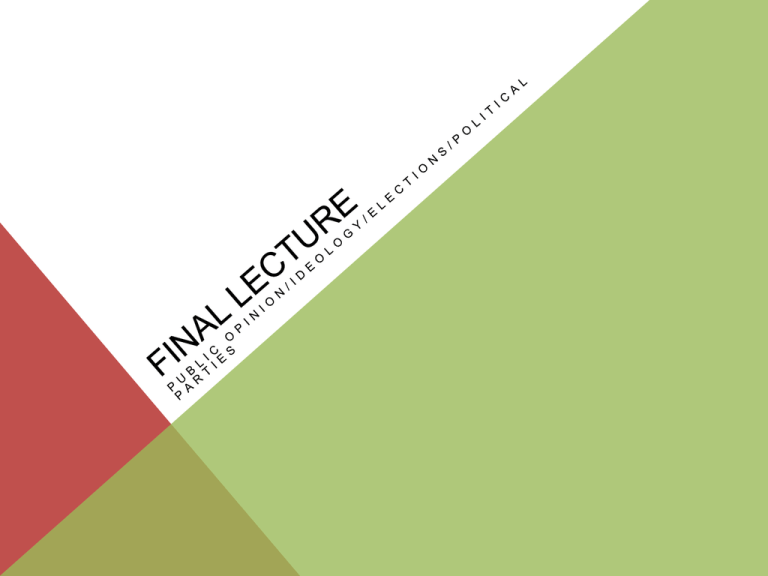
PUBLIC OPINION AND IDEOLOGY Chapter 6 in your book Public opinion is defined: The aggregate of individual attitudes or beliefs shared by some portion of the adult population HOW PUBLIC OPINION IS FORMED It is formed by Political Socialization People acquire political attitudes which include their party affiliation through relationship with their families, friends, co-workers, Church, organizations THE FAMILY Parents have a tremendous impact on your political ideology. If the family is conservative or liberal the children tend to adopt a similar point of view when they grow up. DO YOU FEEL DIFFERENTLY FROM YOUR PARENTS ABOUT THE SUBJECT OF ABORTION? 1. My parents are antiabortion and so am I 2. My parents are antiabortion and I am prochoice 3. My parents are prochoice and I am anti abortion. 33% 33% 33% 1 2 3 EDUCATION The public school system was created in order to promote the American character and to assimilate Americans to the same American values. Teachers and professors impact the ideology of their students PEER PRESSURE If all your friends are liberal you tend to become liberal. If all your friends are conservative, you tend to become conservative THE MEDIA SHAPES PEOPLE’S ATTITUDES Major media (cable channels and Newspapers tend to be liberal) Talk radio tend to be conservative IMPACT OF POLITICAL EVENTS Life style effect: When you have to pay mortgage and taxes, you become more conservative. Renters are more liberal Generational effect: young vs Old 9-11, the Great Depression, The Reagan Era. DEMOGRAPHIC INFLUENCE Demographics is the study and measurement of the population. (census, ethnic make up, age of population, gender, migration). How education impact ideology. The more education people have the more liberal they tend to become. Economic status: Family income: Low income tend to vote Democrats RELIGION Protestant Christians tend to vote Republican Catholic and Jewish tend to vote Democrat ETHNICITY/GENDER Blacks tend to vote Democrats Whites vote more Republicans Latinos are split Asians are split Jewish vote Democrat. More women vote Democrat More men vote Republican GEOGRAPHIC IMPACT The South and Mountain States tend to be Republican The Coasts (North East and West) tend to vote Democrat The Midwest tend to split between Democrats and Republicans IDEOLOGY AND PUBLIC OPINION . Type: PNG IDEOLOGY © Copy right 1999 2004 Questio ns, Comme nts, or Hate Mail w ebmast er@peo plesfort heameri canway .org . Ideolo gical Spectr um: is an attemp t to show the two main forces of Politic s, i.e., the Right verses the Left. Also, how the Extrem es of each ultimat ely can becom e Tyran ny. Repub lican, Democ rat, Indepe ndent, or Liberta rian can fall within this Spectr um-limited to the moder ate ends of the spectr um. Sociali sm, Comm unism, Fascis m, also fall within this spectr um, but beyon d the moder ate, toward the Extrem e, and most often, includi ng Tyran ny. Think of this Ideolo gical Spectr um as deline ating The Force verses The Empir e, a laStar Wars. A note about the confor mity plot: Confor mity spans betwe en Anarch y--Free Will; and adhere nce to the norms, i.e., "For the Comm on Good," "Majori ty Rules. " -Relate d Pages : -------------Politic al Spectr um -------------Forms of Gover nment s -------------Left-vRight -------------Media Contr ol of the Politic al Proce ss HOME . © Copy right 1999 2004 Questio ns, Comme nts, or Hate Mail w MORE IDEOLOGY Website for this image displays the ideological spectru. calguns.net ... •Full-size image •388 × 389 (Same sizex larger), 57KB •More Type: sizes •Search by image •Similar images Images may be subject to copyright. PNG AMERICAN IDEOLOGY • Economic issues • Social • issues progressive liberal Conservative Orthodox COMBINATION OF IDEOLOGIES 1) Social liberal economic progressive 2) Social liberal economic conservative 3) Social orthodox economic conservative 4) social orthodox economic progressive WHAT IS YOUR IDEOLOGY? 25% 25% 25% 25% 1 2 3 4 MEASURING PUBLIC OPINION Random sampling Representative sampling Sampling errors 100, 500, 1000, 5000+ CHAPTER 7: INTEREST GROUPS Pluralism, Federalist 10, Factions Interest groups demand policy changes that benefit their own group. Why so many? Because: Freedom of Assembly in the Constitution Federalism (Geographic diversity) Immigration (ethnic and cultural diversity) The large House of Representatives (district diversity) TYPES OF INTEREST GROUPS Economic and business: Real estate lobby, tax payers groups, chamber of commerce Agricultural, Labor Unions Environmental Interest Groups Public Interest Groups: Consumerism Foreign lobbies Civil Rights Groups LOBBYING AND REVOLVING DOOR Rules on gifts Registration of lobbyists CHAPTER 8: POLITICAL PARTIES Group of political activists who share certain values and are organized as a group to win elections. WHY DO WE HAVE 2 DOMINANT PARTIES Our system of representation by districts and states in which winner takes all favors two major parties and two major candidates In Countries that have proportional representation and in which gaining a small percentage of the vote is sufficient for the purpose of representation tend to have more parties. HISTORY OF POLITICAL PARTIES 1) Federalists vs Democratic Republicans 2) Era of Good Feelings 1816-1824 only one party 3) Jacksonian Democracy: Whigs vs Democrats 4) Civil War: Republican vs Democrats 3RD PARTIES Anti-masonic party Republican Party Progressive Bull Moose Ross Perot United We Stand America The Reform Party REPUBLICANS AND DEMOCRATS TODAY Social and Economic Beliefs The Big Tent The Decline of Party affiliation (DECLINE TO STATE OR INDEPENDENT) 9: Low voter turnout vs mandatory voting THE ELECTORAL COLLEGE Who are the electors? How many ( Number of representatives+2 senators 538 So How many do you need to win? California make up 20% of victory. 10: PRESIDENTIAL CAMPAIGNS The nomination process Primaries: closed vs open Caucus State convention THE NATIONAL CONVENTION The schedule of primaries The purpose of the National convention (choosing the nominee and the vice president) The National Elections
